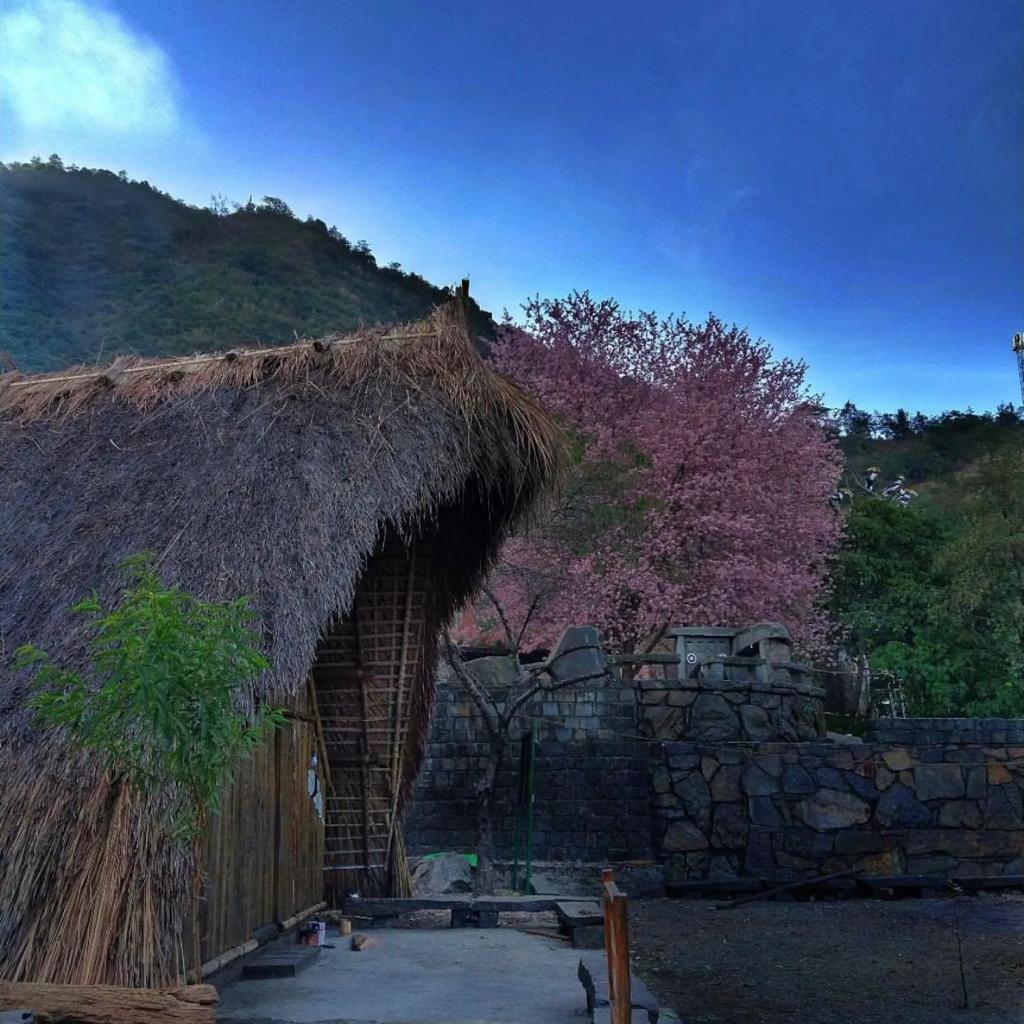Nagaland, nestled in northeastern India, is a land of vibrant cultures, diverse tribes, and a rich heritage that dates back centuries. While not yet recognised as UNESCO World Heritage Site, Nagaland boasts numerous attractions that offer a captivating glimpse into its unique history and traditions. From ancient ruins to vibrant festivals, each heritage site carries a story of its own, showcasing the pride and resilience of the Naga people.
- Naga Heritage Village, Kisama: Where Tradition Meets Modernity
One of the most prominent cultural sites in Nagaland is the Naga Heritage Village in Kisama, located just a short distance from the capital city of Kohima. This village comes alive during the annual Hornbill Festival, celebrated in December, where various Naga tribes gather to display their traditions, art, music, dance, and culinary delights.
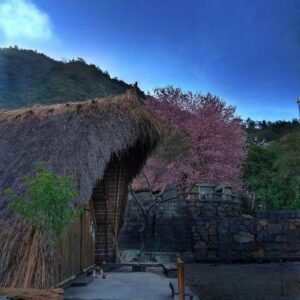
The Naga Heritage Village is a melting pot of diverse cultures, allowing visitors to witness the distinctiveness of each tribe. Traditional huts, adorned with intricate wood carvings and thatched roofs, give visitors an insight into the architecture and lifestyle of the tribes. The festival atmosphere is electrifying as locals don their colourful traditional attire and engage in lively performances, making it a must-visit for anyone seeking an immersive experience of Nagaland’s living heritage.
You must travel to Kohima, the capital city of Nagaland, as Kisama is located just a short distance away from Kohima: You can travel:
- By Air:
The nearest airport to Kohima is Dimapur Airport (DIM), which is well-connected to major cities in India. After reaching Dimapur, you can hire a taxi or take a bus to Kohima, approximately 74 kilometres away. The journey from Dimapur to Kohima takes 2 to 3 hours, depending on road conditions and traffic.
- By Train:
Dimapur is the nearest railway station to Kohima. Several trains from different parts of India connect to Dimapur Railway Station (DMV). After arriving at Dimapur, you can hire a taxi or take a bus to Kohima, which is around 74 kilometres away. The journey by road usually takes 2 to 3 hours.
- By Road:
Kohima is well-connected by road to major cities in the neighbouring states. You can take a bus or hire a taxi to reach Kohima. Nagaland State Transport Corporation (NSTC) and private bus operators provide regular bus services to and from Kohima.
- By Taxi:
Once you reach Kohima, you can hire a taxi or use local shared cabs to reach the Naga Heritage Village in Kisama. The village is approximately 12 kilometres from Kohima, and the journey usually takes around 30 to 45 minutes, depending on traffic and road conditions.
- By Rental Car or Bike:
If you prefer more flexibility and independence, consider renting a car or a bike in Kohima and driving to Kisama. It allows you to explore the region at your own pace and enjoy the scenic beauty of the surrounding hills.
Important Tips:
- It’s advisable to check the weather conditions and road status before planning your trip, especially during the monsoon season when landslides may occur.
- Ensure you have enough cash, as ATMs might be limited in rural areas.
- Respect the local customs and traditions while visiting the Naga Heritage Village and other sites in Nagaland.
- Remember to plan your trip and make accommodation arrangements in Kohima if you intend to stay there during the Hornbill Festival, which usually takes place in December. Exploring the Naga Heritage Village in Kisama will undoubtedly be a memorable experience, immersing you in the rich cultural tapestry of Nagaland.
- Khonoma Village: A Living Chronicle of Naga Resistance
Khonoma Village, situated in the picturesque hills of Nagaland, holds a unique historical significance. It was the site of a historic battle between the British colonial forces and the local Angami tribe, who displayed extraordinary valour and defended their land fiercely. The Khonoma Village stands as a testament to the indomitable spirit and bravery of the Naga people during the colonial era.
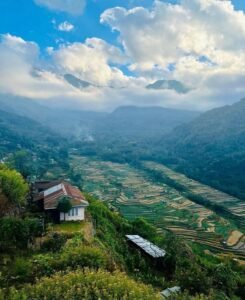
Besides its historical importance, Khonoma is renowned for its eco-friendly initiatives, making it one of Asia’s first green villages. The village showcases sustainable living practices, harmoniously blending with its natural surroundings. It is an ideal place for travellers interested in learning about the coexistence of traditional Naga culture with modern environmental consciousness.
To reach the Naga Heritage Village in Kisama, you must travel to Kohima, the capital city of Nagaland, as Kisama is just a short distance from Kohima. Here are the different modes of transportation you can consider:
- By Air:
The nearest airport to Kohima is Dimapur Airport (DIM), which is well-connected to major cities in India. After reaching Dimapur, you can hire a taxi or take a bus to Kohima, approximately 74 kilometres away. The journey from Dimapur to Kohima takes 2 to 3 hours, depending on road conditions and traffic.
- By Train:
Dimapur is the nearest railway station to Kohima. Several trains from different parts of India connect to Dimapur Railway Station (DMV). After arriving at Dimapur, you can hire a taxi or take a bus to Kohima, which is around 74 kilometres away. The journey by road usually takes 2 to 3 hours.
- By Road:
Kohima is well-connected by road to major cities in the neighbouring states. You can take a bus or hire a taxi to reach Kohima. Nagaland State Transport Corporation (NSTC) and private bus operators provide regular bus services to and from Kohima.
- By Taxi:
Once you reach Kohima, you can hire a taxi or use local shared cabs to reach the Naga Heritage Village in Kisama. The village is approximately 12 kilometres from Kohima, and the journey usually takes around 30 to 45 minutes, depending on traffic and road conditions.
- By Rental Car or Bike:
If you prefer more flexibility and independence, consider renting a car or a bike in Kohima and driving to Kisama. It allows you to explore the region at your own pace and enjoy the scenic beauty of the surrounding hills.
Important Tips:
- It’s advisable to check the weather conditions and road status before planning your trip, especially during the monsoon season when landslides may occur.
- Ensure you have enough cash, as ATMs might be limited in rural areas.
- Respect the local customs and traditions while visiting the Naga Heritage Village and other sites in Nagaland.
- Remember to plan your trip and make accommodation arrangements in Kohima if you intend to stay there during the Hornbill Festival, which usually takes place in December. Exploring the Naga Heritage Village in Kisama will undoubtedly be a memorable experience, immersing you in the rich cultural tapestry of Nagaland.
- Dzukou Valley: A Natural Wonder and Cultural Gem
While not solely recognised for its cultural heritage, Dzukou Valley holds a special place in Nagaland’s heart. This picturesque valley, shared with the neighbouring state of Manipur, offers breathtaking landscapes, especially during the monsoon season when vibrant Dzukou lilies bloom.

For the Naga people, Dzukou Valley holds spiritual and cultural significance. It is often considered a sacred site where various tribes perform rituals and festivals. The valley’s allure is not just in its natural beauty but also in the mythical stories and beliefs passed down through generations.
Reaching Dzukou Valley requires some effort as it is a remote and pristine location situated on the border of Nagaland and Manipur. The valley is a popular trekking destination known for its stunning landscapes and seasonal Dzukou lilies. Here’s how you can reach Dzukou Valley:
- By Air:
The nearest airport to Dzukou Valley is Dimapur Airport (DIM) in Nagaland. From Dimapur, you can hire a taxi or take a bus to reach Kohima, the capital city of Nagaland, about 74 kilometres away. After reaching Kohima, you’ll need to make further arrangements to reach the trekking starting point, Viswema Village.
- By Train:
The nearest railway station to Dzukou Valley is Dimapur Railway Station (DMV) in Nagaland. After arriving at Dimapur, you can hire a taxi or take a bus to reach Kohima, about 74 kilometres away. From Kohima, you’ll need to make further arrangements to reach Viswema Village.
- By Road:
From Kohima, you can hire a taxi or take a shared cab to reach Viswema Village, the starting point for the trek to Dzukou Valley. The distance between Kohima and Viswema Village is around 20 kilometres, and the journey typically takes about 1 to 1.5 hours, depending on road conditions.
- Trekking to Dzukou Valley:
The trek to Dzukou Valley starts from Viswema Village. The route takes you through lush forests, meadows, and streams, offering breathtaking views. The trek is difficult and can take approximately 4 to 6 hours to reach Dzukou Valley from Viswema, depending on your pace and fitness level.
Important Tips:
- Hiring a local guide or joining a trekking group for your safety and to navigate the trail better is recommended.
- Carry sufficient water, snacks, and basic medical supplies during the trek.
- Wear comfortable trekking shoes and appropriate clothing, as the weather can be unpredictable in the mountains.
- Obtain any necessary permits or permissions from local authorities before starting your trek.
- Be eco-conscious and avoid littering the trail or the valley. Respect the natural environment and leave no trace.
- Dzukou Valley is a paradise for nature lovers and adventure enthusiasts. It’s pristine beauty, and tranquil surroundings make it a rewarding destination for those willing to venture off the beaten path. Remember to plan your trip well in advance, especially during the favourable trekking months from October to April, and prepare for an awe-inspiring experience in the lap of nature.
- Kachari Ruins: Traces of an Ancient Kingdom
In the district of Dimapur, you can find the remnants of the Kachari Kingdom, an ancient civilisation that once thrived in the region. The Kachari Ruins offer a glimpse into the architectural ingenuity of the past, with the remains of ancient temples and structures made from bricks and stone.
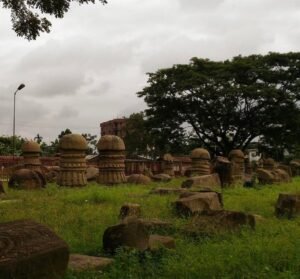
Though not as well-preserved as other historical sites, the Kachari Ruins still contain mystery and intrigue. Exploring these ancient remnants transports visitors back in time, provoking curiosity about the lives of the people who lived in the kingdom centuries ago.
The Kachari Ruins are located in Dimapur, Nagaland. Dimapur is the largest city in the state and is well-connected by various modes of transportation. Here’s how you can reach the Kachari Ruins:
- By Air:
The nearest airport to Dimapur is Dimapur Airport (DIM), which is well-connected to major cities in India. After arriving at the airport, you can hire a taxi or take a local bus to reach the Kachari Ruins. The ruins are located within the city and are easily accessible by road.
- By Train:
Dimapur has a railway station called Dimapur Railway Station (DMV), connected to major cities in India. Upon arriving at the railway station, you can hire a taxi or take a local bus to reach the Kachari Ruins.
- By Road:
Dimapur is well-connected by road to major cities in the neighbouring states. You can drive to Dimapur or take a bus from neighbouring towns and cities. Nagaland State Transport Corporation (NSTC) and private bus operators provide regular bus services to and from Dimapur. Once in Dimapur, you can easily reach the Kachari Ruins by taxi or local transport.
- By Taxi or Local Transport:
After reaching Dimapur, you can hire a taxi or use local auto-rickshaws or cycle-rickshaws to reach the Kachari Ruins. The ruins are located within the city, and it should not be difficult to find transportation to the site.
Important Tips:
- The Kachari Ruins are an archaeological site, and respecting and preserving the heritage while visiting is essential. Do not touch or remove any artifacts or structures.
- Carry water and wear comfortable walking shoes, as you may need to explore the ruins on foot.
- Visiting the Kachari Ruins during daylight hours is advisable for a better and safer experience.
- The Kachari Ruins offer a fascinating glimpse into the region’s historical heritage. As you explore the site, you’ll come across ancient structures and artifacts that reflect the rich history of the Kachari Kingdom. Enjoy your visit and take in the historical significance of this unique archaeological site in Nagaland.
- Veda Peak (Mount Saramati): The Roof of Nagaland
For adventure seekers and trekkers, Veda Peak, also known as Mount Saramati, is a must-visit destination. Located near the India-Myanmar border, this majestic peak is the highest point in Nagaland. The journey to the summit takes travellers through dense forests, scenic landscapes, and remote Naga villages, offering an opportunity to experience the traditional lifestyle and hospitality of the locals.
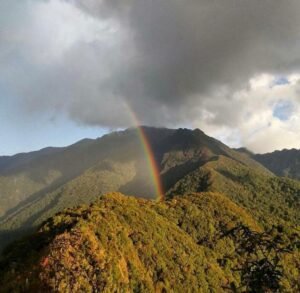
Reaching the top of Veda Peak rewards visitors with breathtaking panoramic views, making it an unforgettable experience.
To reach Veda Peak, also known as Mount Saramati, you must travel to the northeastern state of Nagaland in India. Veda Peak is the highest point in Nagaland, near the India-Myanmar border. Here’s how you can reach Veda Peak:
- By Air:
The nearest airport to Veda Peak is Dimapur Airport (DIM) in Nagaland. From Dimapur, you can hire a taxi or take a bus to reach Kiphire, the base point for the trek to Veda Peak.
- By Train:
The nearest railway station to Veda Peak is Dimapur Railway Station (DMV) in Nagaland. After arriving at Dimapur, you can hire a taxi or take a bus to reach Kiphire, the starting point for the trek to Veda Peak.
- By Road:
You can hire a taxi or take a bus from Dimapur to Kiphire. The distance between Dimapur and Kiphire is approximately 290 kilometres, and the journey usually takes around 7 to 9 hours, depending on road conditions and traffic. Kiphire is a small town in Nagaland and serves as the base for the trek to Veda Peak.
- Trekking to Veda Peak:
The trek to Veda Peak starts from Kiphire. It is a challenging trek and requires good physical fitness and preparation. The trail takes you through dense forests, picturesque landscapes, and the beautiful Naga countryside. The trek usually takes 2 to 3 days to reach the summit of Veda Peak and back, depending on the pace and weather conditions.
Important Tips:
- Ensure you are well-prepared with proper trekking gear, including sturdy hiking shoes, warm clothing, and essential supplies.
- Hiring a local guide or joining a trekking group for safety and to navigate the trail better is advisable.
- Carry sufficient water and energy snacks for the trek, as there might not be many facilities along the way.
- Respect the local customs and traditions while interacting with the communities in the region.
- Reaching Veda Peak requires some effort, but the panoramic views from the summit and the unique experience of trekking through the Naga hills make it a rewarding adventure. Enjoy the beauty of the natural landscapes and immerse yourself in the rich culture and hospitality of the Nagaland region as you embark on this unforgettable journey to Veda Peak.
Preserving the Treasures of Nagaland’s Heritage
Nagaland’s heritage sites are a source of pride for the local communities and an essential part of India’s cultural tapestry. While the region’s heritage sites may not have yet attained UNESCO recognition, their significance cannot be undermined. Local authorities and communities continue to work diligently to preserve and protect these sites, ensuring that future generations can learn about and appreciate the rich heritage of Nagaland.
As you plan your journey to Nagaland, take a step beyond the popular tourist spots, and delve into the lesser-known heritage sites that carry the essence of Naga traditions and history. Embrace the warmth of the Naga culture, immerse yourself in the colourful festivals, and discover the stories that have shaped this enigmatic land throughout the ages.
